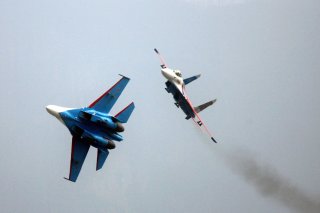China’s Su-27 Flanker Is a Poor Copy of the Russian Original
Looks can be majorly deceiving.
Here's What You Need to Remember: Beijing received seventy-six fighters from Moscow in 1992 to replace their aging Soviet-supplied fighters. They were liked so much that China negotiated a deal with Russia which meant up to two-hundred licensed copies of the Su-27 could be manufactured in China using Russian-supplied kits.
China’s J-11 looks like an exact copy of Russia’s Su-27. And it almost is—but it’s nowhere near as reliable or capable.
Export Time
The Su-27 was developed by the Soviet Union at the tail end of the Cold War and was intended to play more or less the same role as the American F-14 or F-15 fighters—a fast and maneuverable air escort or air superiority fighter. Moscow’s Flankers would have protected the Soviet Union’s long-range bombers like the Tu-22, Tu-95, and Tu-160. Today, it still serves in this role with the Russian Air Force.
It is obvious why China would want to domestically produce the Su-27 Flanker—it’s agile, has a high top speed, and good range. In fact, the Su-27 is supermaneuverable. For a time, it was the airframe of choice for the Russian Knights, an aerobatic demonstration team similar to the U.S. Navy’s Blue Angels.
It is also well-armed with ten external hardpoints for an extensive weapons loadout, and an internally housed 30 millimeter cannon. One of the critical drawbacks of the Su-27 is that it is not capable of aerial refueling and so can’t feed its thirsty twin-engine design.
In the aftermath of the Soviet Union’s dissolution, a cash-strapped Russia turned to the outside world for potential weapons export customers and found a receptive client—China.
Production
Beijing received seventy-six fighters from Moscow in 1992 to replace their aging Soviet-supplied fighters. They were liked so much that China negotiated a deal with Russia which meant up to two-hundred licensed copies of the Su-27 could be manufactured in China using Russian-supplied kits.
Fast forward to 2003, and Chinese copies of the Su-27—the J-11—are being built, possibly without Russian consent. It is possible that these airframes were reverse-engineered copies not covered by the earlier licensing agreement.
Russian media raised alarm bells. In an interview, the director of Rosoboronexport said that “the Chinese side outwardly copied the Su-27 is what the Russian side was talking about. Maybe this is a fact…” It may be hard to prove definitively, as outside appearances do not necessarily indicate what the “guts” of the airframe are made of.
Engine Light On
Two crucial pieces of equipment not covered by the technology transfer agreement between the two countries were engines and avionics.
China had struggled for many years to master domestic engine production and the Su-27/J-11 was no exception. Early copies suffered from poor engine reliability. Russian defense experts were quoted as saying that “China is still dependent on us [Russia] and will stay that way for some time to come.”
Some of the lessons learned from the J-11 were incorporated into the J-15, another knock-off copy of the Su-27, though that airframe is also unreliable and dangerous for pilots and aircraft carriers.
Knock-off
Even though the J-11 designs are capable, their capabilities are also somewhat limited. The designs that they were based on are from the late 1970s—making them nearly forty years old. They are also not stealthy—and crucially do not support aerial refueling which is a severe hindrance.
Still, there is absolutely no question that the J-11 draws very heavily from the Su-27 Flanker design. But at this point, considering the age of the design, it probably doesn’t matter much.
Caleb Larson is a Defense Writer with The National Interest. He holds a Master of Public Policy and covers U.S. and Russian security, European defense issues, and German politics and culture.
Image: Reuters

